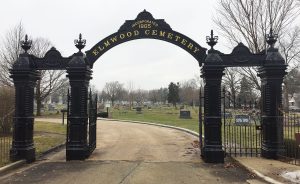Wrought iron gates give Sycamore’s Civil War-era cemetery a claim to fame
Marcia McCarthy for Chronicle Media — January 25, 2017
The wrought iron gates an entrances to Sycamore’s Elmwood Cemetery are unaltered and remain in good shape since the burials grounds opened in 1865.
It’s quiet and peaceful inside Sycamore’s Elmwood Cemetery and in the surrounding neighborhood of older and unassuming one- and two-story frame houses.
But the burial grounds, which opened in 1865, nonetheless have an attention-getting claim to fame among preservationists and lovers of classic 19th century architectural design.
A pair of ornate wrought iron entry gates greet visitors at two entries—one on Charles Street and one on South Cross Street.
Added to the the National Register of Historic Places in 1978, the Elmwood Cemetery gates are among 15 DeKalb properties so honored.
But why give special attention to a pair of gates? The 1978 nomination form explains why.
The years from 1850 until after the Civil War saw rapid expansion in the use of cast iron for structural and ornamental building. The Elmwood Gates, the nomination explains, “are significant as an example of cast iron urban furniture (sic) during a time when most decorative cast iron was utilized in building facades.”
The iron portions “reflect skill in wrought iron craftsmanship, with the overall design exhibiting an artistic union of cast and wrought iron construction.”
The gates consist of three openings, the central one arched and wider than the others. Four







